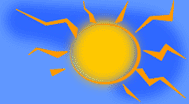|
The following paragraphs are borrowed from the hht site. If you wish further information, please click on the link at the
bottom of the page, and you can learn much more about this condition.
"The following Diagnostic Criteria for
HHT were recently published by an international group of HHT experts. The diagnosis of HHT is considered ??finite if three
or more of the following four criteria are present ??spected if two of the following four criteria are present 1) Nosebleeds-
spontaneous and recurrent 2) Telangiectasia- multiple, at characteristic sites, including lips, oral cavity, fingers and nose.
3) Internal telangiectasia or AVM- lung, brain, GI, liver or spinal 4) Family history-parent, sibling or child with HHT according
to these criteria.
No one with HHT has all of the signs and symptoms listed below. One of the very characteristics
of HHT is its extreme variability even with a family. A parent may have horrible nosebleeds, but no AVM in an internal organ.
Yet, their child may have a nosebleed only rarely but AVMs in one or more internal organ. We also can not predict how likely
someone is to have one of the hidden, internal AVMs based on how many nosebleeds or skin telangiectasia they have. In other
words, the person with HHT who has infrequent nosebleed is as likely to have an AVM in their lung as the person with HHT who
gets severe daily nosebleeds.
Telangiectasia in the nose, along with the nosebleeds they cause, are the most common
signs of HHT. About 95% of people with HHT have recurring nosebleeds by the time they reach middle age. The average age at
which nosebleeds begin is 12, but they can begin as early as infancy, or as late as adulthood. The nosebleeds can be as infrequent
as once or twice a year, or can occur daily. When a nosebleed occurs it can last only seconds, or occasionally hours. The
amount of blood lost may be one or two drops, or enough to require a blood transfusion. As with most things that are variable
in human beings (i.e. height and shoe size), the majority of people with HHT are in between the two extremes.
Telangictasia
in the skin of the hands, face and mouth are also found in about 95% of all people with HHT. These often do not become apparent
until the 30s or 40s, however. They appear as small red to purplish spots or distinct areas of delicate, lacy red vessels.
In some individuals with HHT they become quite prominent by late adulthood, in others they are subtle. These telangiectasia
on the skin and in the mouth can bleed also, but they are less likely to than those in the nose. Both telangiectasia of the
skin and nosebleeds have a tendency to be come more numerous with increasing age. But with this too, there are many exceptions!
About 25% of those with HHT will develop GI bleeding. Again, it can range from mild to severe. Telangiectasia can
be found anywhere in the gastrointestinal system, including the esophagus (swallowing tube), the stomach, the small intestines,
and the colon (large intestines). Most commonly, the stomach and the beginning of the small intestines are involved. They
look similar to telangiectasia on the skin. Telangiectasia in the GI tract do not cause pain or discomfort. Symptoms of GI
bleeding are black or bloody stools and/or anemia. Anemia (low blood count) in turn can cause fatigue, shortness of breath,
chest pain or lightheaded feelings.
Approximately 30% of people with HHT have one or more AVM in the lungs (pulmonary
AVM or PAVM). AVMs in the lung have a risk to rupture, particularly during pregnancy in women when blood pressure and blood
volume tends to increase. This can be life-threatening. However, there are additional concerns about untreated lung AVMs.
The capillaries between an artery and vein in the lung have functions in addition to slowing down the blood in an artery before
it enters the vein. These capillaries act as a filter for impurities (clots, bacteria, air bubbles) in the blood, before the
blood circulates to the brain. Someone with a lung AVM above a certain size is thus at significant risk for stroke (what happens
when a clot goes to the brain) or brain abscess (a brain infection that can result from a bacteria getting to the brain).
Stoke and brain abscess can also be life-threatening or disabling. Fortunately, lung AVMs are usually easily and completely
treatable. The recommended screening and treatment for them is described below.
Brain AVMs are found in about 15%
of people with HHT and can also be successfully treated in most cases. They can be life threatening or disabling if they bleed.
Since they often do not cause symptoms of warning prior to bleeding, we strongly recommend screening for them in all people
with HHT. Spinal AVMs are more rare and can also be removed. They can cause pain in the back over the spine, or loss of feeling
or function in an arm or leg.
Liver AVMs can also occur, but their frequency in HHT is not well known. They are
unlikely to rupture and most are not currently treated. Large AVMs in the liver sometimes cause heart and liver failure, usually
later in life. Heart failure can occur if the heart has been overworked for years, pumping extra blood through the low resistance
pathway of an AVM (in this context an AVM is sometimes called a Shunt), as well as through all the normal vessels of the body."
*1
*1.http://www.hht.org/whatis.asp
Take me to HHT.org for more information
|

